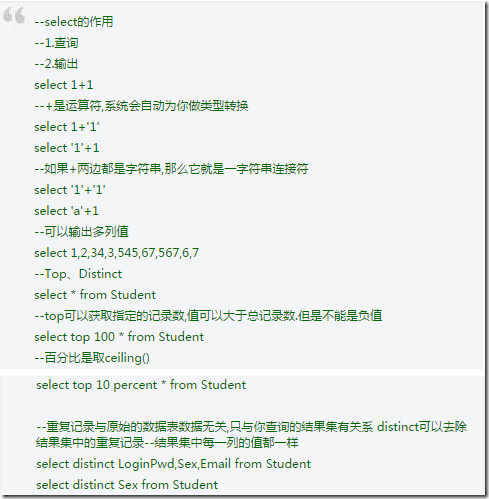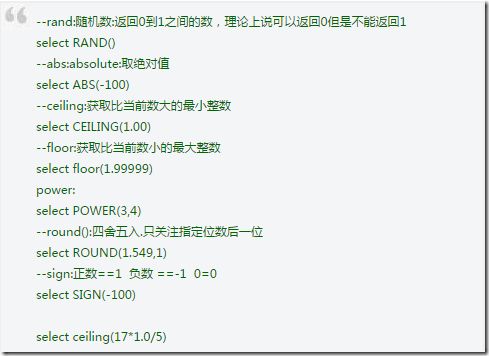本文内容
- SQL 语句
- 创建数据库
- 创建数据表
- 数据完整性约束
- 四种基本字符类型说明
- SQL 基本语句
- 类型转换函数
- 日期函数
- 数学函数
- 字符串函数
- 合并结果集 union
- CASE 函数用法
- IF ELSE 语法
- WHILE 循环语法
- 子查询
- 表连接 join
- 事务
- 视图
- 触发器
- 存储过程
- 分页存储过程
- 索引
- 临时表
1,SQL 语句
SQL 语言:结构化的查询语言(Structured Query Language),是关系数据库管理系统的标准语言。是一种解释语言,写一句执行一句,不需要整体编译执行。
语法特点:
- 1.没有“ ”,字符串使用‘ ’包含
- 2.没有逻辑相等,赋值和逻辑相等都是=
- 3.类型不再是最严格的。任何数据都可以包含在‘ ’以内
- 4.没有 bool 值的概念,但是在视图中可以输入true/false
- 5.有关系运算符:> < >= <= = <> != ,它返回一个bool值
- 6.有逻辑运算符: !(not) &&(and) ||(or)
- 7.不区别大小写
2,创建数据库
语法:
create database 数据库名称
on primary --默认在主文件组上
(
name='逻辑名称_data' , --当你发现它不是一句完整的sql语句,而仅仅是一个处理结构中的某一句的时候,就需要添加 ,
size=初始大小, --数值不包含在‘’以内
filegrowth=文件增长 ,
maxsize=最大容量,
filename='物理路径'
)
log on
(
name='逻辑名称_log' , --当你发现它不是一句完整的sql语句,而仅仅是一个处理结构中的某一句的时候,就需要添加 ,
size=初始大小, --数值不包含在‘’以内
filegrowth=文件增长 ,
maxsize=最大容量, --一般来说日志文件不限制最大容量
filename='物理路径'
)
示例:
3,创建数据表
语法:
create table 表名
(
字段名称 字段类型 字段特征(是否为null,默认值 标识列 主键 唯一键 外键 check约束),
字段名称 字段类型 字段特征(是否为null,默认值 标识列 主键 唯一键 外键 check约束)
)
创建老师表Teacher :Id、Name、Gender、Age、Salary、Birthday
示例:
4,数据完整性约束
实体完整性:实体就是指一条记录。这种完整性就是为了保证每一条记录不是重复记录。是有意义的
-- 主键:非空和唯一.一个表只有一个主键,但是一个主键可以是由多个字段组成的 组合键
-- 标识列:系统自动生成,永远不重复
-- 唯一键:唯一,但是可以为null,只能null一次
域完整性:域就是指字段,它是为了保证字段的值是准和有效,合理值
-- 类型 是否null,默认值,check约束,关系
自定义完整性:
-- check约束,存储过程 触发器
引用完整性:一个表的某个字段的值是引用自另外一个表的某个字段的值。引用的表就是外键表,被引用的表就是主键表
-- 1.建立引用的字段类型必须一致
-- 2.建立引用的字段的意义一样
-- 3.建立主外键关系的时候选择 外键表 去建立主外键关系
-- 4.建立主外键关系的字段在主表中必须是主键或者唯一键
-- 5.对于操作的影响 :
-- 01.在添加数据时,先添加主键表再添加外键表数据
-- 02.在删除的时候先外键表数据再删除主键表数据
-- 级联的操作:不建议使用:会破坏数据完整性
-- 不执行任何操作:该报错就报错,该删除就删除
-- 级联:删除主表记录,从表引用该值的记录也被删除
-- 设置null:删除主表记录,从表对应的字段值设置为null,前提是可以为null
-- 设置为default:删除主表记录,从表对应的字段值设置为default,前提是可以为default
主键约束(PK Primary key) 唯一键约束(UQ unique) 外键约束(FK foreign key) 默认值约束(DF default) check约束(CK check)
语法:
alter table 表名
add constraint 前缀_约束名称 约束类型 约束说明(字段 关系表达式 值)
示例:
5,四种基本字符类型说明
6,SQL基本语句
数据插入
调用方法 一 一对应原则:类型对应,数量对应,顺序对应
语法: 形参 实参
insert into 表名([字段列表]) values(值列表) --数据必须要符合数据完整性
插入操作是单个表的操作
插入操作insert一次只能插入一条记录
数据删除
语法:
delete [from] 表名 where 条件
示例:
数据更新(修改):一定需要考虑是否有条件
语法:
update 表名 set 字段=值,字段=值 … where 条件
示例:
数据查询
语法: *代表所有字段
select */字段名称列表 from 表列表
示例:
7,类型转换函数
8,日期函数
gedate、dateadd、datediff、datename、datepart 函数。
9,数学函数
rand、abs、ceiling、floor、power、round、sign 函数。
10,字符串函数
charindex、len、lower、right、left、substring、replace、stuff 函数。
11,合并结果集 union
12,CASE 函数用法
相当于 switch case---c#中的switch...case只能做等值判断
这可以对字段值或者表达式进行判断,返回一个用户自定义的值,它会生成一个新列
2.要求then后面数据的类型一致
1.第一种做等值判断的case..end
case 字段或者表达式
when .值..then .自定义值
when .值..then .自定义值
.....
else 如果不满足上面所有的when就满足这个else
end
示例:
--显示具体班级的名称
select StudentNo,StudentName,
case ClassId --如果case后面接有表达式或者字段,那么这种结构就只能做等值判断,真的相当于switch..case
when 1 then '一班'
when 2 then '2班'
when 3 then '3班'
when null then 'aa' --不能判断null值
else '搞不清白'
end,
sex
from Student
--2.做范围判断,相当于if..else,它可以做null值判断
--case --如果没有表达式或者字段就可实现范围判断
-- when 表达式 then 值 --不要求表达式对同一字段进行判断
-- when 表达式 then 值
-- .....
--else 其它情况
--end
select StudentNo,StudentName,
case
when BornDate>'2000-1-1' then '小屁孩'
when BornDate>'1990-1-1' then '小青年'
when BornDate>'1980-1-1' then '青年'
--when Sex='女' then '是女的'
when BornDate is null then '出生不详'
else '中年'
end
from Student
--百分制转换为素质教育 90 -A 80--B 70 --C 60 --D <60 E NULL--没有参加考试
select StudentNo,SubjectId,
case
when StudentResult>=90 then 'A'
when StudentResult>=80 then 'B'
when StudentResult>=70 then 'C'
when StudentResult>=60 then 'D'
when StudentResult is null then '没有参加考试'
else 'E'
end 成绩,
ExamDate
from Result
13,IF ELSE 语法
1.没有{},使用begin..end.如果后面只有一句,可以不使用begin..end包含
2.没有bool值,只能使用关系运算符表达式
3.也可以嵌套和多重
4.if后面的()可以省略
示例:
declare @subjectname nvarchar(50)='office' --科目名称declare @subjectId int=(select Subjectid from Subject where SubjectName=@subjectname) --科目IDdeclare @avg int --平均分set @avg=(select AVG(StudentResult) from Result where SubjectId=@subjectId and StudentResult is not null) --获取平均分print @avgif @avg>=60beginprint '成绩不错,输出前三名:'select top 3 * from Result where SubjectId=@subjectId order by StudentResult descendelsebeginprint '成绩不好,输出后三名:'select top 3 * from Result where SubjectId=@subjectId order by StudentResultend
14,WHILE 循环语法
没有{},使用begin..end
没有bool值,需要使用条件表达式
可以嵌套
也可以使用break,continue
示例:
go
declare @subjectName nvarchar(50)='office' --科目名称
declare @subjectId int--科目ID
declare @classid int =(select classid from Subject where SubjectName=@subjectName) --查询当前科目属于那一个班级
set @subjectId=(select SubjectId from Subject where SubjectName=@subjectName) --获取科目ID
declare @totalCount int --总人数 :那一个班级需要考试这一科目
set @totalCount=(select COUNT(*) from Student where ClassId=@classid)
print @totalcount --14
declare @unpassNum int --不及格人数
set @unpassNum=(select COUNT(distinct Studentno) from Result where SubjectId=@subjectId and StudentNo in(select StudentNo from Student where ClassId=@classid) and StudentResult<60)
while(@unpassNum>@totalCount/2)
begin
--执行循环加分
update Result set StudentResult+=2 where SubjectId=@subjectId and StudentNo in(select StudentNo from Student where ClassId=@classid) and StudentResult<=98
--重新计算不及格人数
set @unpassNum=(select COUNT(distinct Studentno) from Result where SubjectId=@subjectId and StudentNo in(select StudentNo from Student where ClassId=@classid) and StudentResult<60)
end
go
declare @subjectName nvarchar(50)='office' --科目名称
declare @subjectId int--科目ID
declare @classid int =(select classid from Subject where SubjectName=@subjectName) --查询当前科目属于那一个班级
set @subjectId=(select SubjectId from Subject where SubjectName=@subjectName) --获取科目ID
declare @totalCount int --总人数
set @totalCount=(select COUNT(*) from Student where ClassId=@classid)
print @totalcount --14
declare @unpassNum int --不及格人数
while(1=1)
begin
set @unpassNum=(select COUNT(distinct Studentno) from Result where SubjectId=@subjectId and StudentNo in(select StudentNo from Student where ClassId=@classid) and StudentResult<60)
if(@unpassNum>@totalCount/2)
update Result set StudentResult+=2 where SubjectId=@subjectId and StudentNo in(select StudentNo from Student where ClassId=@classid) and StudentResult<=98
else
break
end
15,子查询
子查询,是一个查询中包含另外一个查询。
1.子查询的使用方式:使用()包含子查询
2.子查询分类:
1)独立子查询:子查询可以直接独立运行,例如:
查询比“王八”年龄大的学员信息
select * from Student where BornDate<(select BornDate from Student where StudentName='王八')
2)相关子查询:子查询使用了父查询中的结果
示例:
--子查询的三种使用方式
--1.子查询做为条件,子查询接在关系运算符后面 > < >= <= = <> !=,如果是接这关系运算符后面,必须保证 子查询只返回一个值
--查询六期班的学员信息
select * from Student where ClassId=(select ClassId from grade where classname='八期班')
--子查询返回的值不止一个。当子查询跟随在 =、!=、<、<=、>、>= 之后,或子查询用作表达式时,这种情况是不允许的。
select * from Student where ClassId=(select ClassId from grade)
--查询八期班以外的学员信息
--当子查询返回多个值(多行一列),可以使用in来指定这个范围
select * from Student where ClassId in(select ClassId from grade where classname<>'八期班')
--当没有用 EXISTS 引入子查询时,在选择列表中只能指定一个表达式。如果是多行多列或者一行多列就需要使用exists
--使用 EXISTS 关键字引入子查询后,子查询的作用就相当于进行存在测试。外部查询的 WHERE 子句测试子查询返回的行是否存在
select * from Student where EXISTS(select * from grade)
select * from Student where ClassId in(select * from grade)
--2.子查询做为结果集--
select top 5 * from Student --前五条
--使用top分页
select top 5 * from Student where StudentNo not in(select top 5 studentno from Student)
--使用函数分页 ROW_NUMBER() over(order by studentno),可以生成行号,排序的原因是因为不同的排序方式获取的记录顺序不一样
select ROW_NUMBER() over(order by studentno),* from Student
--查询拥有新生成行号的结果集 注意:1.子查询必须的别名 2.必须为子查询中所有字段命名,也就意味着需要为新生成的行号列命名
select * from (select ROW_NUMBER() over(order by studentno) id,* from Student) temp where temp.id>0 and temp.id<=5
select * from (select ROW_NUMBER() over(order by studentno) id,* from Student) temp where temp.id>5 and temp.id<=10
select * from (select ROW_NUMBER() over(order by studentno) id,* from Student) temp where temp.id>10 and temp.id<=15
--3.子查询还可以做为列的值
select (select studentname from student where studentno=result.studentno),(select subjectname from subject where subjectid=result.SubjectId), StudentResult from Result
--使用Row_number over()实现分页
--1.先写出有行号的结果集
select ROW_NUMBER() over(order by studentno),* from Student
--2.查询有行号的结果集 子查询做为结果集必须添加别名,子查询的列必须都有名称
select * from (select ROW_NUMBER() over(order by studentno) id,* from Student) temp where id>0 and id<=5
--查询年龄比“廖杨”大的学员,显示这些学员的信息
select * from Student where BornDate<(select BornDate from Student where StudentName='廖杨')
--查询二期班开设的课程
select * from Subject where ClassId=(select ClassId from grade where classname='二期班')
--查询参加最近一次“office”考试成绩最高分和最低分
--1查询出科目 ID
select subjectid from Subject where SubjectName='office'
--2.查询出这一科目的考试日期
select MAX(ExamDate) from Result where SubjectId=(select subjectid from Subject where SubjectName='office')
--3,写出查询的框架
select MAX(StudentResult),MIN(StudentResult) from Result where SubjectId=() and ExamDate=()
--4.使用子查询做为条件
select MAX(StudentResult),MIN(StudentResult) from Result where SubjectId=(
select subjectid from Subject where SubjectName='office'
) and ExamDate=(
select MAX(ExamDate) from Result where SubjectId=(
select subjectid from Subject where SubjectName='office'
)
)
16,表连接 join
--1.inner join :能够找到两个表中建立连接字段值相等的记录
--查询学员信息显示班级名称
select Student.StudentNo,Student.StudentName,grade.classname
from Student
inner join grade on Student.ClassId=grade.ClassId
--左连接: 关键字前面的表是左表,后面的表是右表
--左连接可以得到左表所有数据,如果建立关联的字段值在右表中不存在,那么右表的数据就以null值替换
select PhoneNum.*,PhoneType.*
from PhoneNum
left join PhoneType on PhoneNum.pTypeId=PhoneType.ptId
--右连接: 关键字前面的表是左表,后面的表是右表
--右连接可以得到右表所有数据,如果建立关联的字段值在右左表中不存在,那么左表的数据就以null值替换
select PhoneNum.*,PhoneType.*
from PhoneNum
right join PhoneType on PhoneNum.pTypeId=PhoneType.ptId
--full join :可以得到左右连接的综合结果--去重复
select PhoneNum.*,PhoneType.*
from PhoneNum
full join PhoneType on PhoneNum.pTypeId=PhoneType.ptId
17,事务
事务处理,要么都能成功执行,要么都不执行。
事务的四个特点 ACID:
- A:原子性:事务必须是原子工作单元;对于其数据修改,要么全都执行,要么全都不执行。它是一个整体,不能再拆分
- C:一致性:事务在完成时,必须使所有的数据都保持一致状态。。某种程度的一致
- I:隔离性:事务中隔离,每一个事务是单独的请求将单独的处理,与其它事务没有关系,互不影响
- D:持久性:如果事务一旦提交,就对数据的修改永久保留
使用事务:
将你需要操作的sql命令包含在事务中
1.在事务的开启和事务的提交之间
2.在事务的开启和事务的回滚之间
三个关键语句:
开启事务:begin transaction
提交事务:commit transaction
回滚事务:rollback transaction
declare @num int =0 --记录操作过程中可能出现的错误号
begin transaction
update bank set cmoney=cmoney-500 where name='aa'
set @num=@num+@@ERROR
--说明这一句的执行有错误 但是不能在语句执行的过程中进行提交或者回滚
--语句块是一个整体,如果其中一句进行了提交或者回滚,那么后面的语句就不再属于当前事务,
--事务不能控制后面的语句的执行
update bank set cmoney=cmoney+500 where name='bb'
set @num=@num+@@ERROR
select * from bank
if(@num<>0 ) --这个@@ERROR只能得到最近一一条sql语句的错误号
begin
print '操作过程中有错误,操作将回滚'
rollback transaction
end
else
begin
print '操作成功'
commit transaction
end
--事务一旦开启,就必须提交或者回滚
--事务如果有提交或者回滚,必须保证它已经开启
18,视图
视图是一张虚拟表,可以像使用子查询做为结果集一样使用视图
select * from vw_getinfo
使用代码创建视图
语法:
create view vw_自定义名称
as
查询命令
go
--查询所有学员信息
if exists(select * from sysobjects where name='vw_getAllStuInfo')
drop view vw_getAllStuInfo
go --上一个批处理结果的标记
create view vw_getAllStuInfo
as
--可以通过聚合函数获取所以记录数
select top (select COUNT(*) from Student) Student.StudentNo,Student.StudentName,grade.ClassId,grade.classname from Student
inner join grade on Student.ClassId=grade.ClassId order by StudentName --视图中不能使用order by
--select * from grade --只能创建一个查询语句
--delete from grade where ClassId>100 --在视图中不能包含增加删除修改
go
--使用视图。。就像使用表一样
select * from vw_getAllStuInfo
--对视图进行增加删除和修改操作--可以对视图进行增加删除和修改操作,只是建议不要这么做:所发可以看到:如果操作针对单个表就可以成功,但是如果 多张的数据就会报错:不可更新,因为修改会影响多个基表。
update vw_getAllStuInfo set classname='asdas' ,studentname='aa' where studentno=1
19,触发器
触发器:执行一个可以改变表数据的操作(增加删除和修改),会自动触发另外一系列(类似于存储过程中的模块)的操作。
语法:
create trigger tr_表名_操作名称
on 表名 after|instead of 操作名称
as
go
if exists(select * from sysobjects where name='tr_grade_insert')
drop trigger tr_grade_insert
go
create trigger tr_grade_insert
on grade for insert ---为grade表创建名称为tr_grade_insert的触发器,在执行insert操作之后触发
as
declare @cnt int
set @cnt = (select count(*) from student)
select * ,@cnt from student
select * from grade
go
--触发器不是被调用的,而是被某一个操作触 发的,意味着执行某一个操作就会自动触发 触发器
insert into grade values('fasdfdssa')
---替换触 发器:本来需要执行某一个操作,结果不做了,使用触 发器中的代码语句块进行替代
if exists(select * from sysobjects where name='tr_grade_insert')
drop trigger tr_grade_insert
go
create trigger tr_grade_insert
on grade instead of insert ---为grade表创建名称为tr_grade_insert的触发器,在执行insert操作之后触发
as
declare @cnt int
set @cnt = (select count(*) from student)
select * ,@cnt from student
select * from grade
go
insert into grade values('aaaaaaaaaaaa')
go
---触 发器的两个临时表:
--inserted: 操作之后的新表:所有新表与原始的物理表没有关系,只与当前操作的数据有关
--deleted:操作之前的旧表:所有新表与原始的物理表没有关系,只与当前操作的数据有关
if exists(select * from sysobjects where name='tr_grade_insert')
drop trigger tr_grade_insert
go
create trigger tr_grade_insert
on grade after insert
as
print '操作之前的表:操作之前,这一条记录还没有插入,所以没有数据'
select * from deleted
print '操作之后的表:已经成功插入一条记录,所有新表中有一条记录'
select * from inserted
go
--测试:
insert into grade values('aaaaa')
if exists(select * from sysobjects where name='tr_grade_update')
drop trigger tr_grade_update
go
create trigger tr_grade_update
on grade after update
as
print '操作之前的表:存储与这个修改操作相关的没有被修改之前的记录'
select * from deleted
print '操作之后的表:存储这个操作相关的被修改之后 记录'
select * from inserted
go
--测试
update grade set classname=classname+'aa' where ClassId>15
if exists(select * from sysobjects where name='tr_grade_delete')
drop trigger tr_grade_delete
go
create trigger tr_grade_delete
on grade after delete
as
print '操作之前的表:存储与这个修改操作相关的没有被删除之前的记录'
select * from deleted
print '操作之后的表:存储这个操作相关的被删除之后 记录--没有记录'
select * from inserted
go
--测试
delete from grade where ClassId>15
20,存储过程
参数,返回值,参数默认值,参数:值的方式调用
在调用的时候有三个对应:类型对应,数量对应,顺序对应
创建语法:
create proc usp_用户自定义名称
对应方法的形参 --(int age, out string name)
as
对应方法体:创建变量,逻辑语句,增加删除修改和查询..return返回值
go
调用语法:
Exec 存储过程名称 实参,实参,实参 ...
示例:
--获取所有学员信息
if exists(select * from sysobjects where name='usp_getAllStuInfo')
drop proc usp_getAllStuInfo
go
create procedure usp_getAllStuInfo
as
select * from Student
go
--调用存储过程,获取的有学员信息
execute usp_getAllStuInfo
--exec sp_executesql 'select * from Student'
--查询指定性别的学员信息
go
if exists(select * from sysobjects where name='usp_getAllStuInfoBySex')
drop proc usp_getAllStuInfoBySex
go
create procedure usp_getAllStuInfoBySex
@sex nchar(1) --性别 参数不需要declare
as
select * from Student where Sex=@sex
go
--调用存储过程,获取指定性别的学员信息
Exec usp_getAllStuInfoBySex '女'
--创建存储过程获取指定班级和性别的学员信息
go
if exists(select * from sysobjects where name='usp_getAllStuInfoBySexandClassName')
drop proc usp_getAllStuInfoBySexandClassName
go
create procedure usp_getAllStuInfoBySexandClassName
@classname nvarchar(50), --班级名称
@sex nchar(1)='男'--性别 有默认的参数建议写在参数列表的最后
as
declare @classid int ---班级ID
set @classid=(select classid from grade where classname=@classname) --通过参数班级名称获取对应的班级ID
select * from Student where Sex=@sex and ClassId=@classid
go
--执行存储过程获取指定班级和性别的学员信息
--exec usp_getAllStuInfoBySexandClassName '八期班'
exec usp_getAllStuInfoBySexandClassName default, '八期班' --有默认值的参数可以传递default
exec usp_getAllStuInfoBySexandClassName @classname='八期班' --也可以通过参数=值的方式调用
exec usp_getAllStuInfoBySexandClassName @classname='八期班' ,@sex='女'
exec usp_getAllStuInfoBySexandClassName @classname='八期班',@sex='女'
--创建存储过程,获取指定性别的学员人数及总人数
go
if exists(select * from sysobjects where name='usp_getCountBySexandClassName')
drop proc usp_getCountBySexandClassName
go
create procedure usp_getCountBySexandClassName
@cnt int=100 output, --output标记说明它是一个输出参数。output意味着你向服务器请求这个参数的值,那么在执行的时候,服务器发现这个参数标记了output,就会将这个参数的值返回输出
@totalnum int =200output, --总人数
@className nvarchar(50), --输入参数没有默认值,在调用的时候必须传入值
@sex nchar(1)='男'--输入参数有默认值,用户可以选择是否传入值
as
declare @classid int ---班级ID
set @classid=(select classid from grade where classname=@classname) --通过参数班级名称获取对应的班级ID
select * from Student where Sex=@sex and ClassId=@classid
set @cnt= (select COUNT(*) from Student where Sex=@sex and ClassId=@classid) --获取指定班级和性别的总人数
set @totalnum=(select COUNT(*) from Student) ----获取总人数
go
--调用存储过程,获取指定性别的学员人数及总人数
declare @num int,@tnum int
exec usp_getCountBySexandClassName @cnt=@num output ,@totalnum=@tnum output , @className='八期班'
print @num
print @tnum
print '做完了'
---获取指定班级的人数
if exists(select * from sysobjects where name='usp_getCount')
drop proc usp_getCount
go
create procedure usp_getCount
@className nvarchar(50)='八期班'
as
declare @classid int=(select classid from grade where classname=@className)
declare @cnt int
set @cnt =(select COUNT(*) from Student where ClassId=@classid)
--return 只能返回int整数值
--return '总人数是'+cast(@cnt as varchar(2))
return @cnt
go
--调用存储过程,接收存储过程的返回值
declare @count int
--set @count=(exec usp_getCount)
exec @count=usp_getCount '八期班'
print @count
if exists(select * from sysobjects where name='usp_getClassList')
drop proc usp_getClassList
go
create procedure usp_getClassList
as
select classid,classname from grade
go
21,分页存储过程
if exists(select * from sysobjects where name='usp_getPageData')
drop proc usp_getPageData
go
create procedure usp_getPageData
@totalPage int output,--总页数
@pageIndex int =1 ,--当前页码,默认是第一页
@pageCount int =5 --每一页显示的记录数
as
select * from (select ROW_NUMBER() over(order by studentno) id,* from Student) temp where temp.id>(@pageindex-1)*@pagecount and temp.id<=(@pageindex*@pagecount)
set @totalPage=CEILING((select COUNT(*) from Student)*1.0/@pageCount)
go
22,索引
select * from sysindexes
--create index IX_Student_studentName
--on 表名(字段名)
--clustered index:聚集索引 nonclustered index--非聚集索引
if exists(select * from sysindexes where name='IX_Student_studentName')
drop index student.IX_Student_studentName
go
create clustered index IX_Student_studentName
on student(studentname)
--如果是先创建主键再创建聚集索引就不可以,因为主键默认就是聚集索引
--但是如果先创建聚集索引,那么还可以再创建主键,因为主键不一定需要是聚集的
23,临时表
--创建局部临时表
create table #newGrade
(
classid int ,
classname nvarchar(50)
)
---局部临时表只有在当前创建它的会话中使用,离开这个会话临时表就失效.如果关闭创建它的会话,那么临时表就会消失
insert into #newGrade select * from grade
select * from #newGrade
select * into #newnewnew from grade
select * into newGrade from #newgrade
--创建全局临时表:只要不关闭当前会话,全局临时表都可以使用,但是关闭当前会话,全局临时表也会消失
create table ##newGrade
(
classid int ,
classname nvarchar(50)
)
drop table ##newGrade
select * into ##newGrade from grade
select * from ##newGrade
--创建表变量
declare @tb table(cid int,cname nvarchar(50))
insert into @tb select * from grade
select * from @tb

























